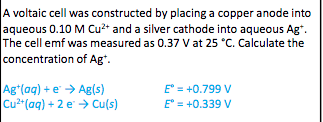1) A constant current of 0.800 A is run through the electrolytic cell in order to produce oxygen (gas) at the anode:
2 H2O â O2(g) + 4 e- + 4 H+
The amount (in grams) of O2 obtained after 15.2 min of electrolysis is [X] g
2) Electrolysis of a solution of Tl3+ produces deposition of elemental thallium, Tl, at the cathode. The time (in min.) needed for a constant current of 1.20 A to deposit 0.500 g of Tl(s) is [X] min.
3) An electrochemical cell is described by the following line notation:
Zn(s) Ç Zn2+(aq) (0.0420 M) ÇÇ Tl3+(aq) (9.06Ã10-2 M), Tl+(aq) (0.0400 M) Ç Pt(s).
Given: E°(Zn2+/Zn) = - 0.763 V; E°(Tl3+/Tl+) = + 1.25 V.
The potential on the cathode half-cell, E+ = V; the potential on the anode half-cell, E- = V; and the overall cell potential, Ecell = V.
4) Consider electrolysis of molten copper bromide, CuBr2. What is the product of this process obtained (a) at the cathode? (b) at the anode?
1. a) Cathode: Cu(s);
(b) Anode: Br2(l)
2. (a) Cathode: Br2(l);
(b) Anode: Cu(s)
3. (a) Cathode: Cu2+;
(b) Anode: Br-
4. (a) Cathode: Br-;
(b) Anode: Cu2+
5. (a) Cathode: Cu(s);
(b) Anode: O2(g)
6. (a) Cathode: H2(g);
(b) Anode: Cu2+
1) A constant current of 0.800 A is run through the electrolytic cell in order to produce oxygen (gas) at the anode:
2 H2O â O2(g) + 4 e- + 4 H+
The amount (in grams) of O2 obtained after 15.2 min of electrolysis is [X] g
2) Electrolysis of a solution of Tl3+ produces deposition of elemental thallium, Tl, at the cathode. The time (in min.) needed for a constant current of 1.20 A to deposit 0.500 g of Tl(s) is [X] min.
3) An electrochemical cell is described by the following line notation:
Zn(s) Ç Zn2+(aq) (0.0420 M) ÇÇ Tl3+(aq) (9.06Ã10-2 M), Tl+(aq) (0.0400 M) Ç Pt(s).
Given: E°(Zn2+/Zn) = - 0.763 V; E°(Tl3+/Tl+) = + 1.25 V.
The potential on the cathode half-cell, E+ = V; the potential on the anode half-cell, E- = V; and the overall cell potential, Ecell = V.
4) Consider electrolysis of molten copper bromide, CuBr2. What is the product of this process obtained (a) at the cathode? (b) at the anode?
1. a) Cathode: Cu(s);
(b) Anode: Br2(l)
2. (a) Cathode: Br2(l);
(b) Anode: Cu(s)
3. (a) Cathode: Cu2+;
(b) Anode: Br-
4. (a) Cathode: Br-;
(b) Anode: Cu2+
5. (a) Cathode: Cu(s);
(b) Anode: O2(g)
6. (a) Cathode: H2(g);
(b) Anode: Cu2+

